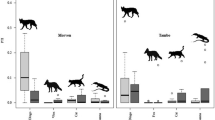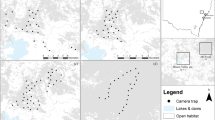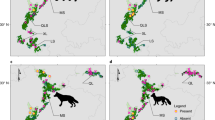Abstract
Mammalian carnivores are particularly vulnerable to extinction in fragmented landscapes1, and their disappearance may lead to increased numbers of smaller carnivores that are principle predators of birds and other small vertebrates. Such ‘mesopredator release’2 has been implicated in the decline and extinction of prey species2,3,4,5,6. Because experimental manipulation of carnivores is logistically, financially and ethically problematic6,7, however, few studies have evaluated how trophic cascades generated by the decline of dominant predators combine with other fragmentation effects to influence species diversity in terrestrial systems. Although the mesopredator release hypothesis has received only limited critical evaluation8 and remains controversial9, it has become the basis for conservation programmes justifying the protection of carnivores6. Here we describe a study that exploits spatial and temporal variation in the distribution and abundance of an apex predator, the coyote, in a landscape fragmented by development. It appears that the decline and disappearance of the coyote, in conjunction with the effects of habitat fragmentation, affect the distribution and abundance of smaller carnivores and the persistence of their avian prey.
This is a preview of subscription content, access via your institution
Access options
Subscribe to this journal
Receive 51 print issues and online access
$199.00 per year
only $3.90 per issue
Buy this article
- Purchase on Springer Link
- Instant access to full article PDF
Prices may be subject to local taxes which are calculated during checkout

Similar content being viewed by others
References
Woodroffe, R. & Ginsberg, J. R. Edge effects and extinction of populations inside protected areas. Science 280, 2126–2128 (1998).
Soulé, M. E. et al. Reconstructed dynamics of rapid extinctions of chaparral-requiring birds in urban habitat islands. Conserv. Biol. 2, 75–92 (1988).
Sovada, M. A., Sargeant, A. B. & Grier, J. W. Differential effects of coyotes and red foxes on duck nest success. J. Wildl. Mgmt 59, 1–9 (1995).
Palomares, F., Gaona, P., Ferreras, P. & Delibes, M. Positive effects on game species of top predators by controlling smaller predator populations: an example with lynx, mongooses, and rabbits. Conserv. Biol. 9, 295–305 (1995).
Rogers, C. M. & Caro, M. J. Song sparrows, top carnivores, and nest predation: a test of the mesopredator release hypothesis. Oecologia 116, 227–233 (1998).
Soulé, M. E. & Terborgh, J. Continental Conservation: Scientific Foundations for Regional Reserve Networks (Island, Washington, (1999).
Estes, J. A. in Linking Species and Ecosystems (eds Jones, C. G. & Lawton, L. H.) 151–158 (Chapman and Hall, New York, (1995).
Litvaitis, J. A. & Villafuerte, R. Intraguild predation, mesopredator release, and prey stability. Conserv. Biol. 10, 676–677 (1996).
Wright, S. J., Gompper, M. E. & Deleon, B. Are large predators keystone species in neotropical forests—the evidence from Barro-Colorado Island. Oikos 71, 279–294 (1994).
Wilcove, D. S. Nest predation in forest tracts and the decline of migratory songbirds. Ecology 66, 1211–1214 (1985).
Churcher, J. B. & Lawton, J. H. Predation by domestic cats in an English village. J. Zool. (Lond.) 212, 439–456 (1987).
Leimgruber, P., McShea, W. J. & Rappole, J. H. Predation on artificial nests in large forest blocks. J. Wildl. Mgmt 58, 254–260 (1994).
Fretwell, S. D. Food chain dynamics: the central theory of ecology? Oikos 50, 291–301 (1987).
George, W. Domestic cats as predators and factors in winter shortages of raptor prey. Wilson Bull. 86, 384–396 (1974).
Bolger, D. T., Alberts, A. & Soulé, M. E. Occurrence patterns of bird species in habitat fragments: sampling, extinction, and nested species subsets. Am. Nat. 137, 155–166 (1991).
Linhart, S. B. & Knowlton, F. F. Determining the relative abundance of coyotes by scent station lines. Wildl. Soc. Bull. 3, 119–124 (1975).
Conner, M. C., Labisky, R. F. & Progulske, D. R. J Scent-station indices as measures of population abundance for bobcats, raccoons, gray foxes, and opossums. Wildl. Soc. Bull. 11, 146–152 (1983).
Bendel, R. B. & Afifi, A. A. Comparison of stepping rules in forward regression. J. Am. Stat. Assoc. 72, 46–53 (1977).
Tabachnick, B. G. & Fidell, L. S. Using Multivariate Statistics 3rd edn (HarperCollins College Publishers, New York, (1996).
Acknowledgements
We thank L. Angeloni, D. Bolger, T. Case, J. Crooks, D. Doak, J. Estes, R. Fisher, S.Hathaway, D. Menendez, S. Minta, P. Raimondi, B. Rice, and A. Suarez for their valuable help with this research, and C. Bell for illustrating Fig. 1 . This work was funded by D. Brimm, an NSF Graduate Research Fellowship, an EPA STAR Fellowship and an American Society of Mammalogist grant (K.R.C.).
Author information
Authors and Affiliations
Corresponding author
Rights and permissions
About this article
Cite this article
Crooks, K., Soulé, M. Mesopredator release and avifaunal extinctions in a fragmented system. Nature 400, 563–566 (1999). https://doi.org/10.1038/23028
Received:
Accepted:
Issue Date:
DOI: https://doi.org/10.1038/23028
This article is cited by
-
Spatial relationships between mesocarnivores and domestic species in an urban environment and implications for endangered San Joaquin kit foxes
Urban Ecosystems (2024)
-
Fox control and fire influence the occurrence of invasive predators and threatened native prey
Biological Invasions (2024)
-
Lethal dog attacks on adult rhesus macaques (Macaca mulatta) in an anthropogenic landscape
Primates (2024)
-
Home range and resource selection of Virginia opossums in the rural southeastern United States
Mammal Research (2024)
-
Assessing habitat selection of the vulnerable Asian small-clawed otters in an anthropized riparian forest of eastern Bangladesh
Mammal Research (2024)
Comments
By submitting a comment you agree to abide by our Terms and Community Guidelines. If you find something abusive or that does not comply with our terms or guidelines please flag it as inappropriate.



